Question (8 marks)
Question a (1 mark)
Select an appropriate charge for each particle below.
Electron: ………..
Proton: …….
Neutron:……….
▶️Answer/Explanation
Ans:
Proton: Positive charge (+)
Neutron: No charge (neutral)
Question b (3 mark)
Most materials are electrically neutral; they contain equal numbers of charged particles. The animation shows that if a cloth is used to rub a plastic rod, the rod becomes positively charged.
Use the animation to explain the process that has occurred between the cloth and the rod, leaving the rod positively charged.

▶️Answer/Explanation
Ans:
When a cloth is used to rub a plastic rod, the process that occurs is known as “triboelectric charging” or “tribocharging.” This process involves the transfer of electrons between the cloth and the rod, resulting in the rod becoming positively charged.
In the animation, when the cloth rubs against the plastic rod, their surfaces come into contact and then separate. During this rubbing action, there is a transfer of electrons between the two materials. The atoms in the cloth have a greater affinity for electrons compared to the atoms in the plastic rod.
As the cloth rubs against the rod, some electrons from the atoms in the rod are transferred to the atoms in the cloth. This transfer of electrons leaves the plastic rod with a deficiency of electrons, resulting in an overall positive charge. At the same time, the cloth gains the extra electrons, acquiring an overall negative charge.
The rubbing action causes the surfaces of the materials to become charged due to the redistribution of electrons. The difference in the electron affinity between the cloth and the plastic rod leads to the plastic rod becoming positively charged, while the cloth becomes negatively charged.
This process of triboelectric charging demonstrates how friction can cause the transfer of charges between materials, resulting in one material acquiring a positive charge and the other material acquiring a negative charge.
Question c (4 mark)
Harry the cat is rolling around on the carpet on a very dry day when he notices a cardboard box nearby full of polystyrene. Wanting to play, he jumps into the box! When Harry is pulled out of the box, the polystyrene pellets are stuck to his fur.
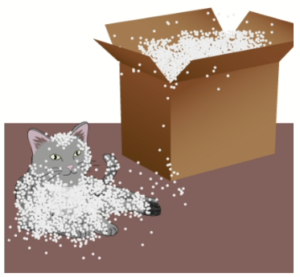
Using the concept of induction, suggest why the polystyrene pellets stick to Harry.
▶️Answer/Explanation
Ans:
The phenomenon of polystyrene pellets sticking to Harry’s fur can be explained by the concept of electrostatic induction. Induction occurs when a charged object, in this case, Harry’s fur, creates an electric field in its surroundings, which then polarizes nearby objects.
On a very dry day, the air tends to have low humidity, which means that it has a lower concentration of water molecules. In such conditions, objects, including Harry’s fur, can become charged due to friction with other surfaces, such as the carpet.
When Harry jumps into the box filled with polystyrene pellets, his charged fur creates an electric field in the surrounding air and within the box. The electric field polarizes the polystyrene pellets, causing a redistribution of charges within them. The pellets are composed of a material that is a good insulator, which means that the charges within the pellets are not easily free to move.
Due to the polarization caused by Harry’s charged fur, the polystyrene pellets acquire temporary opposite charges. The charged fur attracts the oppositely charged regions of the pellets, causing them to stick to Harry’s fur.
This phenomenon of induced polarization and the resulting attraction between charged objects is a common occurrence in electrostatics. It explains why certain materials or objects, like polystyrene pellets, can stick to charged surfaces like Harry’s fur in specific conditions, such as low humidity and the presence of friction.
Question(11marks)
A robotic probe is sent into space to collect data from three of the four inner planets: Mercury, Mars and Venus.
While passing close by each planet the probe drops a test object from a height of 100.0 $\mathrm{m}$, the shape of the object ensures that any frictional forces are negligible over a fall of this distance.
Fly with the probe to collect the data.Below, the name of each planet to measure the time taken for the test object to fall.
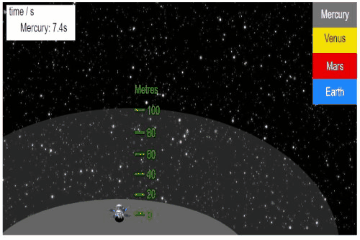
Question a (3 mark)
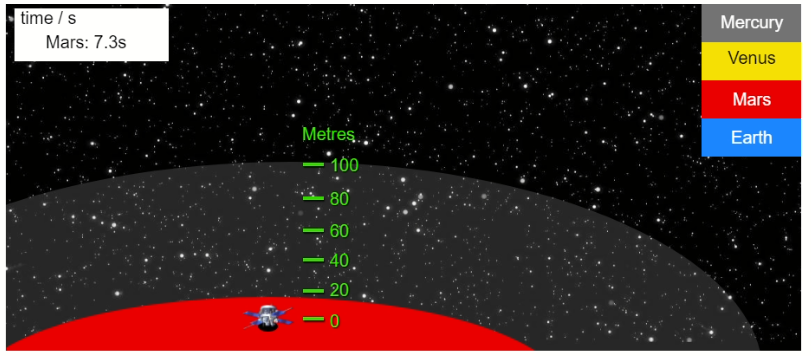
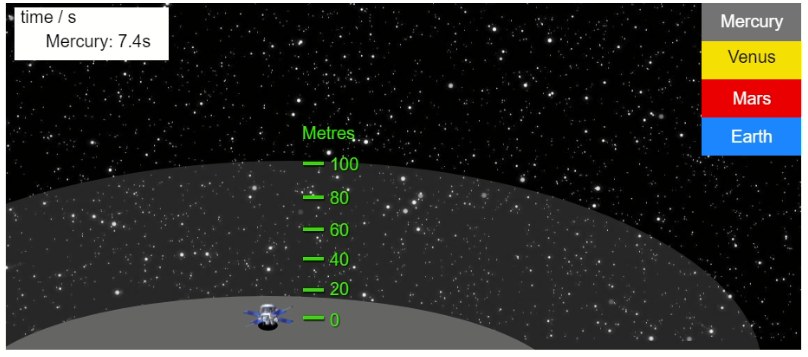
Using the data you collected above, calculate the acceleration due to gravity on Mercury and Mars.
Mercury:
Mars:
▶️Answer/Explanation
Ans:
To calculate the acceleration due to gravity on Mercury and Mars, we can use the equation for free fall:
\[d = \frac{1}{2}gt^2\]
where:
– \(d\) is the distance fallen (100.0 m in this case),
– \(g\) is the acceleration due to gravity, and
– \(t\) is the time taken for the object to fall.
For Mercury:
Distance fallen, \(d = 100.0 \, \mathrm{m}\)
Time taken, \(t = 7.4 \, \mathrm{s}\)
Using the equation above, we can rearrange it to solve for \(g\):
\[g = \frac{2d}{t^2}\]
Substituting the values for Mercury:
\[g_{\text{Mercury}} = \frac{2 \times 100.0 \, \mathrm{m}}{(7.4 \, \mathrm{s})^2}\]
Calculating \(g_{\text{Mercury}}\):
\[g_{\text{Mercury}} \approx 3.7 \, \mathrm{m/s^2}\]
For Mars:
Distance fallen, \(d = 100.0 \, \mathrm{m}\)
Time taken, \(t = 7.3 \, \mathrm{s}\)
Using the equation for \(g\) again:
\[g_{\text{Mars}} = \frac{2d}{t^2}\]
Substituting the values for Mars:
\[g_{\text{Mars}} = \frac{2 \times 100.0 \, \mathrm{m}}{(7.3 \, \mathrm{s})^2}\]
Calculating \(g_{\text{Mars}}\):
\[g_{\text{Mars}} \approx 3.5 \, \mathrm{m/s^2}\]
Therefore, the acceleration due to gravity on Mercury is approximately \(3.7 \, \mathrm{m/s^2}\) and on Mars is approximately \(3.5 \, \mathrm{m/s^2}\).
The scientists receiving the data on Earth know that gravitational field strength $(g)$ is proportional to a planet’s density $(\rho)$ and its radius $(r)$.
gravitational field strength $\sim$ density $\times$ radius
$$
g \sim \rho \times r
$$
The radius of Mercury is about two thirds of the radius of Mars.
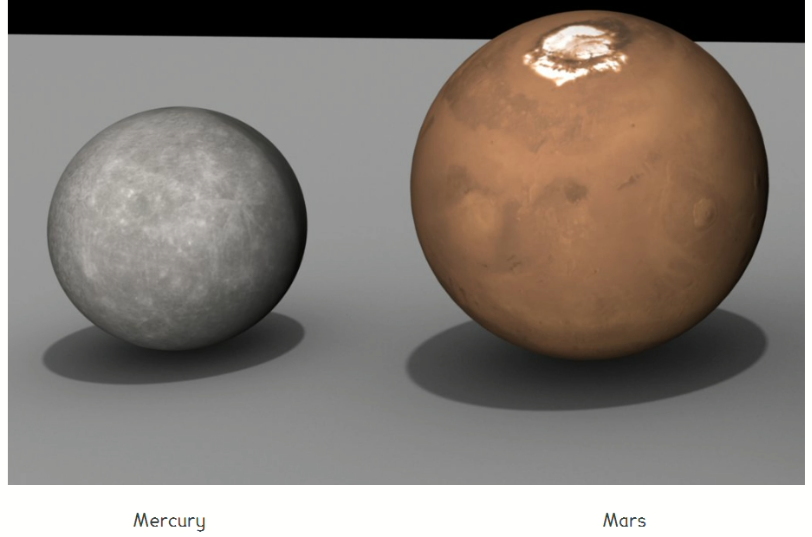
Question b (2 mark)
Explain why Mars and Mercury can have almost the same value of $g$, if Mars has a much larger radius.
▶️Answer/Explanation
Ans:
To explain why Mars and Mercury can have almost the same value of \(g\) despite Mars having a much larger radius, we need to consider the relationship between gravitational field strength, density, and radius.
The equation \(g \sim \rho \times r\) suggests that the gravitational field strength is directly proportional to both the density (\(\rho\)) and the radius (\(r\)) of a planet. However, it is important to note that this equation assumes that the masses of the planets remain constant.
In the case of Mars and Mercury, even though Mars has a significantly larger radius, it is also less dense compared to Mercury. This means that the density of Mars (\(\rho_{\text{Mars}}\)) is relatively lower than the density of Mercury (\(\rho_{\text{Mercury}}\)). The relationship between the radius and density affects the overall value of \(g\) for each planet.
Since Mars has a larger radius but a lower density, the effect of the larger radius on the gravitational field strength is offset by the lower density. On the other hand, even though Mercury has a smaller radius, its higher density compensates for the smaller radius when calculating \(g\). As a result, the two planets can have almost the same value of \(g\) despite their differences in size.
In summary, the combination of the relationship between density and radius plays a crucial role in determining the gravitational field strength. In the case of Mars and Mercury, the larger radius of Mars is counterbalanced by its lower density, allowing the two planets to have similar values of \(g\).
Question c (3 mark)
Next, the space probe visits two of Jupiter’s moons: Io and Ganymede.
The experiment is repeated and again a test object is dropped from a height of $100.0 \mathrm{~m}$.
The gravitational field strength of Io $=1.8 \mathrm{~N} \mathrm{~kg}^{-1}$.
The gravitational field strength of Ganymede $=1.4 \mathrm{~N} \mathrm{~kg}^{-1}$.
The test object has a mass of $20 \mathrm{~kg}$.
Use information from the formula sheet to calculate the gravitational potential energy $\left(E_p\right)$ of the test object before it is dropped over Io.
▶️Answer/Explanation
Ans:
To calculate the gravitational potential energy (\(E_p\)) of the test object before it is dropped over Io, we can use the formula:
\[E_p = m \cdot g \cdot h\]
where:
– \(m\) is the mass of the test object (20 kg),
– \(g\) is the gravitational field strength (1.8 N/kg for Io),
– \(h\) is the height (100.0 m).
Substituting the values:
\[E_p = 20 \, \mathrm{kg} \cdot 1.8 \, \mathrm{N/kg} \cdot 100.0 \, \mathrm{m}\]
Calculating \(E_p\):
\[E_p = 20 \times 1.8 \times 100.0 \, \mathrm{J}\]
\[E_p = 3600 \, \mathrm{J}\]
Therefore, the gravitational potential energy of the test object before it is dropped over Io is \(3600 \, \mathrm{J}\).
Question d (3 mark)
All of the test object’s gravitational potential energy $\left(E_p\right)$ transforms to kinetic energy before hitting the surface of the moons.
The test object travels faster before hitting the surface of Io than it does before hitting the surface of Ganymede. Explain this observation.
▶️Answer/Explanation
Ans:
The observation that the test object travels faster before hitting the surface of Io compared to Ganymede can be explained based on the principle of conservation of energy.
According to the conservation of energy, the total mechanical energy of an object remains constant in the absence of external forces. In this case, as the test object falls from a height, its potential energy (\(E_p\)) is converted into kinetic energy (\(E_k\)). Since there is no mention of any other external forces acting on the object, we can assume that the only forms of energy involved are potential energy and kinetic energy.
The principle of conservation of energy can be expressed as:
\[E_p + E_k = \text{constant}\]
Given that all of the test object’s potential energy (\(E_p\)) transforms into kinetic energy (\(E_k\)) before hitting the surface, we can conclude that the total mechanical energy is conserved. This means that the sum of potential energy and kinetic energy remains constant throughout the fall.
Now, the relationship between potential energy and kinetic energy can be described by the following equation:
\[E_p = E_k\]
Since potential energy is directly proportional to the height from which the object is dropped, a greater height corresponds to a greater potential energy. Therefore, if all of the potential energy is converted into kinetic energy, a greater initial potential energy would result in a greater final kinetic energy.
Applying this concept to the given scenario, the test object has the same mass on both Io and Ganymede. However, the gravitational field strength (and thus potential energy) is higher on Io (1.8 N/kg) compared to Ganymede (1.4 N/kg). Therefore, since all the potential energy transforms into kinetic energy, the test object will have a greater final kinetic energy (and hence greater speed) before hitting the surface of Io compared to Ganymede.
In summary, the observation that the test object travels faster before hitting the surface of Io compared to Ganymede is explained by the conservation of energy. The higher gravitational field strength on Io results in a greater initial potential energy, which is fully converted into kinetic energy, leading to a higher speed of the test object before impact.
Question
The following table contains information that can be used to describe mass or weight.
Select the correct option to complete the table.
$\begin{array}{lll}\text { newton } & \text { size only } & \text { independent of gravitational field strength } \\ \text { kilogram } & \text { size and direction } & \text { dependent on gravitational field strength }\end{array}$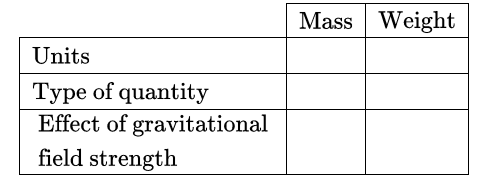
▶️Answer/Explanation
Ans:
Here is the completed table:

Explanation:
- Mass is measured in kilograms (kg) and is a quantity that only considers the size or amount of matter in an object. It does not depend on the gravitational field strength. So, the options “kilogram,” “size only,” and “independent of gravitational field strength” are correct for the “Mass” row.
- Weight is measured in newtons (N) and is a quantity that takes into account both the size and direction of a force due to gravity acting on an object. Weight depends on the gravitational field strength, which can vary depending on the location. Therefore, the options “newton,” “size and direction,” and “dependent on gravitational field strength” are correct for the “Weight” row.
Question:
Use Newton’s law of gravitation to calculate the force of gravity that would act between you and someone standing next to you. What does the size of this force say about how we notice the interaction of gravity?
▶️Answer/Explanation
Ans: Let r = 1 m (distance between centers of mass), M1 = M2 = 70 kg
\(F=\frac{6.67\times 10^{-11}\times 70\times 70}{1^{2}}=3.3\times 10^{-7}N\)
This gravitational force is very small. Generally, we do not notice the interaction of gravity unless the masses involved are very large.
Question:
The graph below shows how the force acting on a 1 kg object changes with its height above the Earth’s surface. How high above the Earth’s surface would you have to go for the gravitational force to have halved from its original strength on the ground?
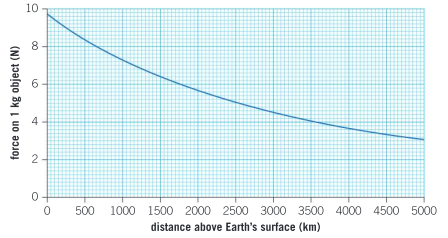
▶️Answer/Explanation
Ans: 2600 km (±100 km)
Question:
What is the length of time between appearances of Halley’s comet?
▶️Answer/Explanation
Ans: 1531–1608 = 77 years
1608–1682 = 74 years
1682–1758 = 76 years
Question:
Is this length of time always the same?
▶️Answer/Explanation
Ans: No
Question:
If the comet was seen in 1066 and 1682, how many times would it have been seen between these years?
▶️Answer/Explanation
Ans: 8 times
Question:
Use your answer above to calculate an average for the length of time between appearances of Halley’s comet.
▶️Answer/Explanation
Ans: \(1682-1066=616; \frac{616}{8}=77\) years (in fact the actual average is about 75 years).
Question:
When was Halley’s comet last visible? When will it next be seen?
▶️Answer/Explanation
Ans: Using multiples of 77 years, Halley’s comet would be observed in 1990 and 2067. In fact, because the time between appearances is not always the same, it was last visible in 1986 and will next appear in 2061.
Question:
Calculate your weight on Earth.
▶️Answer/Explanation
Ans: Let m = 70 kg; 70 × 9.8 = 686 N
Question:
What would your weight be on Mars where g = 3.7 N kg−1?
▶️Answer/Explanation
Ans: Let m = 70 kg; 70 × 3.7= 259 N
Question:
They decide that they should they still measure the same mass of flour on the Moon rather than the same weight. Will this give them the same sized loaf of bread?
▶️Answer/Explanation
Ans: Yes. Mass is not affected by gravity so the amount of each ingredient will remain constant.
Question:
They know that their weighing scales measure weight but give a measurement of mass. Adapt the recipe’s amounts so that they can use their weighing scales from Earth to make a similar loaf of bread on the Moon.
▶️Answer/Explanation
Ans: The same mass of ingredients will have a weight that is 6 times less:
Flour: 82 g
Oil: 6.5 g
Yeast: 1.4 g
Water: 54 g
Salt: 1.4 g
Question:
Will the weaker gravity affect any other parts of the baking process?
▶️Answer/Explanation
Ans: Possibly – will the bread rise more?
Question:
The Sun is about 25,000 light years from the center of the galaxy. Use the graph to determine the Sun’s orbital speed. The mass which causes an object to orbit can be found using the equation: \(M = \frac{rv^{2}}{G}\) where M is the mass which is causing things to orbit it, r is the radius of the orbit, v is the orbital speed (in m s−1) and G is a constant with a value of 6.67 × 10−11 m3 kg−1 s−2.
▶️Answer/Explanation
Ans: 227 km s–1
Question:
One light year is 9.5 × 1015 m. Find the distance from the Sun to the center of the galaxy in meters.
▶️Answer/Explanation
Ans: 25,000 × 9.5 × 1015 = 2.4 × 1020 m
Question:
Use this value and the equation above to calculate the mass causing the Sun to orbit around the galaxy.
▶️Answer/Explanation
Ans: \(\frac{2.4\times 10^{20}\times (227\times 10^{3})^{2}}{6.67\times 10^{-11}}=1.9\times 10^{41}kg\)
Question:
It is estimated that the mass of stars keeping the Sun orbiting the galaxy is about 5 × 1010 solar masses (1 solar mass =2 × 1030 kg). Calculate the mass of stars in the galaxy.
▶️Answer/Explanation
Ans: 2 × 1030 × 5 × 1010 = 1 × 1041 kg
Question:
How does this answer compare to the total mass you calculated in the galaxy?
▶️Answer/Explanation
Ans: Total mass of stars is lower than the total mass of the galaxy.
Question:
You take off a polyester sweater in the dark and notice some sparks. Why does this not happen to the same extent with a woolen sweater?
▶️Answer/Explanation
Ans: Polyester can become negatively whereas wool becomes positively charged. This means that polyester can build up a surplus of electrons, which can easily be lost
Question:
Human hands are very good at acquiring charge; however, a little bit of moisture or sweat stops this effect. Why is this?
▶️Answer/Explanation
Ans: Water is a good electrical conductor (particularly when salts are dissolved in it as they are on the skin). Therefore the charge can easily flow back.
Question:
When you jump up and down on a rubber trampoline, friction can cause you to become positively charged and the trampoline becomes negatively charged. Which surface has gained electrons and which surface has lost some electrons?
▶️Answer/Explanation
Ans: You lose electrons; the trampoline gains electrons.
Question:
Can you describe any other similarities or differences between electrostatic and gravitational forces?
▶️Answer/Explanation
Ans: For example, both have an infinite range, although their strength decreases (as an inverse square) with distance.
Summative assessment
How does lightning occur?
Inside a thunder cloud, ice crystals collide and transfer charge between themselves. Even though the ice crystals are made of the same material, heavier crystals tend to acquire a negative charge
while smaller ice crystals become positively charged. The larger, negatively charged ice crystals sink to the bottom of the thunder cloud and the positively charged ice crystals float to the top.
When the bottom of the thunder cloud has enough charge, it starts to induce a positive charge in the ground underneath it. Atoms in the air experience opposite forces on them as the electrons are pulled towards the ground, while the protons in the atomic nucleus are pulled upwards. When these forces are large enough to pull an electron off the atom, a spark occurs. On this large scale, the spark is a bolt of lightning.
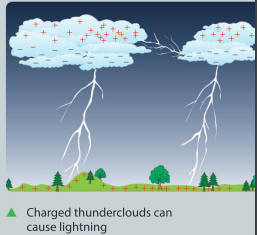
Question:
When lightning strikes, the bottom of the thunder cloud is negatively charged. Determine the direction in which the electrons will travel.
▶️Answer/Explanation
Ans: From the cloud to the ground (negative to positive).
Question:
Explain why the electric field will pull the electrons and the nuclei of air molecules in different directions.
▶️Answer/Explanation
Ans: Electrons are negatively charged and nuclei are positively charged; the negative electrons are attracted downwards, towards the positively charged ground; the positive nuclei are attracted upwards, towards the negatively charged ground.
Question:
The presence of the negatively charged thunder cloud causes the ground to acquire a positive charge by a process caused induction. Explain how this works.
▶️Answer/Explanation
Ans: The electrons in the ground are able to move a little; the nuclei of the atoms are not able to move; opposite charges repel, like charges attract; when the negatively charged cloud is close to the ground, the electrons in the ground are repelled as they are also negatively charged; ground is left with fewer electrons and so has a positive charge.
Question:
A thunder cloud may have a mass of about 2 × 106 kg. Calculate the weight of this thunder cloud. (Use g = 9.8 N kg –1.)
▶️Answer/Explanation
Ans: 9.8 × 2 × 106 = 1.96 × 109 N
Question:
Two thunder clouds with an electric charge will interact with each other through electrostatic and gravitational forces. Which of these interactions would you expect to exert the larger force?
Justify your answer.
▶️Answer/Explanation
Ans: Electrostatic force will be larger; gravitational force is only significant when very large masses interact.
Question:
If the thunder clouds both had the same charge, determine whether they would attract or repel.
▶️Answer/Explanation
Ans: Repel.
Thunder and lightning
A student wants to investigate the link between thunder and lightning. They design an experiment with a Van de Graaff generator. They plan to measure the loudness of the sound of the spark and compare it with the distance that the spark travels.
Question:
What is the dependent variable in this experiment?
▶️Answer/Explanation
Ans: Loudness of the spark.
Question:
Suggest one control variable for this experiment and justify the reason for your choice.
▶️Answer/Explanation
Ans: Award marks for a sensible suggestion (the variable should have the capacity to change the loudness of the spark) that is justified; examples might be: the motor of the Van de Graaff generator should run at the same speed; same lab conditions (temperature and humidity can affect the spark).
Question:
Formulate a hypothesis for this experiment. Explain the reasons for your hypothesis.
▶️Answer/Explanation
Ans: Award marks for a sensible hypothesis that is justified with correct scientific reasoning. For example:
- A larger distance will result in a louder spark;
- If the distance is increased, the generator will need to acquire a larger charge in order to create a spark;
- Due to the increased charge, the spark will transfer more energy;
- Higher energy will result in more sound energy being dissipated;
- Therefore a larger distance will result in a louder spark.
Question:
Write a method for this experiment including any measurements that should be taken.
▶️Answer/Explanation
Ans: Award marks for:
- Taking suitable measurements;
- Suggesting a suitable range of distances;
- Taking suitable repeats;
- A sensible way of measuring the loudness;
- Description of suitable measuring equipment (for example, ruler to measure distance);
- Attempt to keep the control variable (described in question 8) constant.
An experiment to model lightning
The table below shows data for an experiment with a Van de Graaff generator. The Van de Graaff generator was charged and a spark crossed from its dome across to another smaller dome which was earthed. The student changed the distance between the two domes and measured the number of sparks that occurred in a minute.
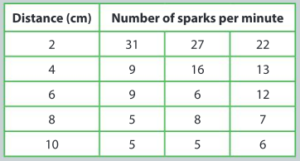
Question:
Plot the data and draw a line of best fit on your graph.
▶️Answer/Explanation
Ans: Take average; plot points correctly; sensible and labelled axis; line of best fit.
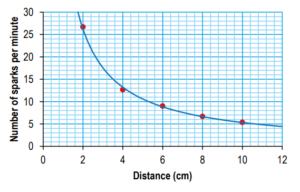
Question:
Explain why is it important to take repeats in this experiment.
▶️Answer/Explanation
Ans: So an average can be taken; exclude anomalous results; take count of natural variation in the number of sparks.
Question:
Determine the distance between the domes at which you would expect to get one spark every 10s.
▶️Answer/Explanation
Ans: 1 every 10 seconds = 6 per minute; reading from graph, distance = 9 cm (allow ± 0.5 cm)
Question:
Describe the trend of the results and comment on the reliability.
▶️Answer/Explanation
Ans: Non-linear; as distance increases, number of sparks decreases at a decreasing rate; trend appears reliable (few anomalies) and data clearly fits the trend.
Question:
Identify one limitation of this experiment and suggest how it might be improved.
▶️Answer/Explanation
Ans: Suggested improvement; would improve experiment; linked to an identified weakness/limitation; justified. An example might be:
Difference between number of sparks counted at 8 cm and 10 cm is small. The method only allows for a whole number of sparks to be counted. Increasing the time over which the number of sparks is counted would enable the number of sparks per minute to be measured with greater precision.
Avoiding lightning
Question:
The taller a building is, the greater the risk of a lightning strike. What solutions to this problem are there?
▶️Answer/Explanation
Ans: Sensible suggestions; for example, a lightning conductor can be installed.
Question:
Carrying an umbrella in a thunderstorm is dangerous, particularly on flat open spaces. Write a paragraph to explain the dangers of this using scientific language in a way that a non-scientist could understand.
▶️Answer/Explanation
Ans: Credit correct use of scientific language; clarity of explanation.
Question:
Give a reference for this paper that would be suitable for a bibliography
▶️Answer/Explanation
Ans: Credit a suitable reference in line with your school’s referencing policy. For example: Acharya, K. and Dibyendu, G. 1 January 2016. Flower inspired thunder protecting umbrella.
Proceedings of the International Conference on Simulation and Modeling Methodologies, Technologies and Applications. Page 136.
Question:
Describe the problem that is being solved here.
▶️Answer/Explanation
Ans: Description of the problem, for example:
- Protecting user from rain;
- Protecting user from lightning.
Question:
Describe the advantages and disadvantages of this solution
▶️Answer/Explanation
Ans: One mark for each advantage/disadvantage. To score 3 or more there should be both advantages and disadvantages. For example:
Advantages:
- Aesthetically pleasing;
- Protects the user of the umbrella while moving;
- Long cable makes it easy to move around.
Disadvantages:
- User has to wear spikes on shoes;
- Attached to a cable.
Question:
The text states that the function of the umbrella “has been shown through computer animation”. Explain why it might be that the umbrella has not been tested in real life, and comment on the ethics of testing this umbrella with people.
▶️Answer/Explanation
Ans: Not tested due to danger/computer modelling is safer; problems of testing with real lightning; comment on unnecessary risk through testing.
